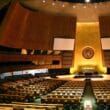Radiological terrorism: The unaddressed threat
By Hubert Foy, April 12, 2016
Fissile material gets all the attention. Well, most of it anyway—whether at the Nuclear Security Summits or here in this roundtable. And that's understandable. Substances that terrorists might fashion into nuclear bombs do deserve the lion's share of attention whenever nuclear security is discussed. But radioactive sources—materials produced because they emit radiation useful in agriculture, industry, construction, medicine, mining, research, and transportation—are quite dangerous in their own right. They number in the millions. Tens of thousands of these sealed radioactive sources—small capsules of highly concentrated radioactive material in solid form—merit real concern. They can be vulnerable to theft and to black-market sale. Worse, they could be used by jihadists to make a radioactive dispersal device, otherwise known as a dirty bomb.
So far, the threats posed by radioactive sources have gone largely unaddressed. To be sure, radioactive sources were introduced to the agenda of the Nuclear Security Summits in 2012, when the Seoul communiqué emphasized the importance of insuring that radiological sources aren't put to malicious use. But four years and two summits later, radioactive sources continue to pose a very real threat. As my colleague Nilsu Goren mentioned in Round One, up to 10 grams of iridium-192 were stolen just last year from a storage facility in Iraq. The material was later recovered, but the incident was alarming. Accordingly, a letter signed by 35 Nobel laureates ahead of the recent summit urged world leaders "to devote the necessary resources to make further substantial progress …in preventing nuclear and radiological terrorism."
Tracking and accounting for radiological sources is not easy. As noted, sources are broadly dispersed and are used in a wide variety of applications. They are often trafficked across borders by smugglers or insiders seeking profit through illegal trade. This means that many radioactive sources lie outside regulatory control and are very vulnerable to misuse. Between 2013 and 2014, some 133 member states reported to the International Atomic Energy Agency (IAEA) at least 276 incidents of illicit trafficking or other unauthorized activity involving radioactive sources. With governments and the private sector unable to trace radioactive material from manufacturer to user and ultimately to safe disposal, chances are unacceptably high that terrorists will someday detonate a dirty bomb.
But opportunities exist for strengthening the protection afforded to radioactive sources—for example, by achieving universal adherence to and implementation of the IAEA's Code of Conduct on the Safety and Security of Radioactive Sources. The code seeks the "development and harmonization of policies, laws, and regulations on the safety and security of radioactive sources." Unfortunately, as of February, only 130 of 168 IAEA member states had committed to the code politically, and only 103 had notified the agency that they intended to act in accordance with the related Guidance on the Import and Export of Radioactive Sources.
Nor have many states established robust, comprehensive legal and regulatory frameworks for radiological security. In Ghana, where I work, President John Mahama last year signed the Nuclear Regulatory Act of 2015, making Ghana just the third country in sub-Saharan Africa with an independent nuclear regulatory authority. Weak legal structures in many countries—along with the lack of universal adherence to the Code of Conduct—mean that a vast number of radiological sources exist outside national and international security mechanisms.
Another opportunity for improved radiological security is to establish regular training and educational opportunities for personnel involved in the management and disposal of radioactive sources. Effective security procedures depend on the behavior of individuals who actually work with radiological devices. New educational and training programs should be developed, specifically tailored for radiological source security, through the IAEA, the International Nuclear Security Education Network, or other entities. All such efforts should be aimed at cultivating a strong security culture.
Finally, the private sector could provide a stronger first line of defense against radioactive material falling into terrorist hands. Radiological best practices should be regarded as an issue of corporate responsibility and instilled across entire industries. Organizations such as the IAEA and the World Institute for Nuclear Security could facilitate international exchanges allowing firms to share best practices. These organizations could also facilitate upgrades to the equipment that firms use for physical protection, accounting, and detection of nuclear smuggling.
Initiatives such as these are not glamorous. But they may be the difference between a normal day in some global capital—and the day when a dirty bomb abruptly forces the world to view radiological security in a new, unpleasant light.
Topics: Nuclear Weapons, Technology and Security
Share: [addthis tool="addthis_inline_share_toolbox"]














